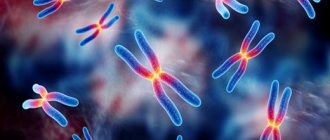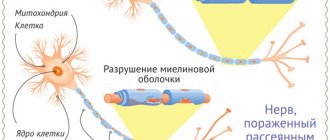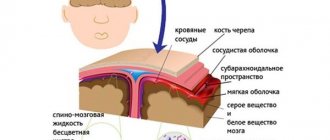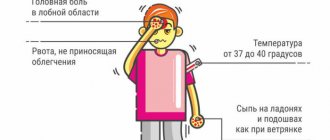Minors may face a serious illness - cerebral palsy. This is a neuralgic disease that is directly related to brain damage.
Its danger lies in the fact that it leads to disability. If you start treating the pathology in time, then you can prevent its development, as well as eliminate some of the symptoms.
Some people are interested in whether cerebral palsy is inherited, and this question is really important. You should understand it in detail in order to understand what to expect from this disease.
Causes
Cerebral palsy is a dangerous disease that significantly reduces the child’s quality of life. It is for this reason that it needs to be treated in time, so that later you do not have to face a significant deterioration in the condition.
In particular, it is important to understand the question of what exactly leads to the occurrence of cerebral palsy. There are several main factors that increase the likelihood of pathology occurring.
Main reasons:
- Hypoxia. It can occur during the period of intrauterine development. In such a situation, the child will lack oxygen, and as a result, various dangerous diseases may develop.
- Various malfunctions in the formation of brain structures.
- Infections acquired during pregnancy. They affect not only the health of the mother, but also the child.
- Brain injuries. They can be obtained both during fetal development and during childbirth. Because of them, various dangerous pathologies can develop that will directly affect the future life of the child.
- Toxic poisoning of the body. This is also a dangerous condition that disrupts the functioning of the central nervous system and other important organs.
- Problems encountered during childbirth. This process does not go smoothly in all cases. As a result, children are faced with diseases, including cerebral palsy.
- Conflict between the Rh factor of the baby and mother.
It should be noted that in most cases the disease is caused not by one factor, but by several. In this case, most often it is hypoxia that leads to pathology, which can be caused by incorrect position of the fetus or early placental abruption.
In any case, if you suspect cerebral palsy, it is important to immediately consult a doctor, because the disease will not go away on its own. Only timely measures taken will significantly improve the patient’s well-being.
Is cerebral palsy inherited?
For every thousand newborns, there is one child with cerebral palsy. This disease and its causes are still being studied in detail. We will tell you whether cerebral palsy is a congenital or acquired disease, and how it is related to genetics.
For a long time it was believed that infantile paralysis has no relationship with heredity. Now scientists are not so clear about the question “is cerebral palsy inherited.”
It has been precisely established that in 2% of cases cerebral palsy is inherited. But still, it cannot be said that cerebral palsy is a hereditary disease. It can be triggered by a hereditary predisposition to certain pathologies.
The essence
Cerebral palsy (cerebral palsy) is caused by a number of factors that cause damage to the child’s brain. The main risk factor is oxygen starvation of the brain, due to which irreversible pathological changes develop in the tissues.
Skeletal muscles change pathologically. Muscle mobility decreases and pain appears. These symptoms are accompanied by others - speech, vision, hearing are impaired, convulsions appear, and pathologies of mental development are observed.
Symptoms are especially pronounced if cerebral palsy of groups 1 and 2 develops.
The term cerebral palsy combines a group of non-progressive chronic movement pathologies. They are secondary, the primary cause lies in brain abnormalities or lesions that develop during the peripartum period.
The most common condition is congenital cerebral palsy. There may also be acquired forms of it.
In adulthood, the likelihood of having a normal personal life and starting a family decreases significantly (we are talking about a pronounced manifestation of the disease).
The problem is that the patient develops visible movement disorders. His limbs don't move correctly.
In 30-50%, motor disorders are accompanied by a slowdown in intellectual development. Most often, intellectual impairment accompanies spastic quadriplegia (one of the forms).
Due to disturbances in the physiology of brain tissue, it is difficult for such children to master speech; they begin to talk later.
Traditionally, the cause of paralysis is considered to be that cells die in certain parts of the brain, or that these lobes initially developed incorrectly.
The changes can vary in intensity - from relatively mild to extremely severe, in which the patient cannot move. Infantile paralysis can result from a number of diseases, for example, polio, epilepsy. Now progressive scientists are increasingly suggesting that genetic predisposition also plays an important role in the development of pathology.
The disease manifests itself in the form of persistent motor disorders. They do not progress during further development of the organism. This gives scientists a reason to traditionally claim that infantile paralysis is not inherited.
Results of the latest research into the causes of cerebral palsy
A child who suffers from paralysis can be easily recognized by characteristic motor impairments: his movements are incorrect or involuntary. The muscles are too tight, causing the limbs to become stiff.
Pakistani scientists conducted observations of families in which children with cerebral palsy of various forms are growing up. It has been established that there is a risk that paralysis will recur in such a family (probability – 1:8). In this case, the autoimmune recessive form is observed mainly. A gene mutation (homozygous) was detected in 4 children. It provokes pathological changes in the protein structure.
After long-term observation of English and Swedish families in which children with paralysis are growing up, scientists identified 2% of patients with the genetic nature of the disease. They had no prenatal or postpartum complications.
Serious research was carried out by Norwegian scientists. They followed nearly 2 million participants using the Norwegian Medical Birth Registry. Data from 1967 to 2002 were analyzed.
Norwegian scientists have found that in families with a sick child, as well as in twins, the risk of developing paralysis increases. If one twin has cerebral palsy, the risk that the other will also develop the disease increases 15 times.
The risk of developing the disease increases if a child with this pathology has already been born in the family. There is a high chance that his next sibling will also get sick. But developmental pathologies of twins and twins may be due to the fact that inside the mother’s womb they simply mechanically interfere with each other.
They have less space to develop, which means the brain receives less oxygen.
If one of the parents has cerebral palsy, the likelihood that this disease will affect the child increases 6 times. The gender of the sick parent does not affect the likelihood of children becoming ill. Studies have not found an increase in incidence if a third-degree relative suffered from paralysis.
The listed facts only confirm that cerebral palsy can rarely depend on genetic factors.
Research is further complicated by the fact that children with paralysis often do not start families. Even if they manage to find a life partner, not everyone decides to have a child. Accordingly, it is not so easy to determine whether a disease is transmitted through genes.
There are many forms of infantile paralysis, some of which are completely independent of genetics.
Weak genes
It is still generally accepted that cerebral palsy is not a hereditary disease, but there are hereditary mechanisms that can influence its development. The severity of symptoms can also be transmitted through genes. We are talking about how resilient the nervous system is, how capable it is of resisting negative factors.
Scientists have no doubt that there is a relationship between pathological changes in the nervous system and the development of the disease. It has been precisely established that there are genes responsible for the state of the central nervous system and its functioning. In 2% of cases, it was found that cerebral palsy is hereditary.
Can broken DNA cause cerebral palsy? Doctors do not rule out the fact that gene disruption indirectly affects the development of paralysis due to malfunctions of the central nervous system.
It is possible that some children are born with a genetic predisposition to a weak nervous system. This can explain the different development of children with the same pathologies (fetal hypoxia, asphyxia, prematurity).
Some children develop normally even after such pathologies, while others develop infantile paralysis in one form or another.
Scientists emphasize that hereditary predisposition may be associated with the following factors:
- blood circulation in the brain tissue is impaired;
- spina bifida develops, blastomatous processes are observed;
- hysteria, stuttering, narcolepsy, epilepsy.
All of these manifestations can accompany cerebral palsy of varying severity.
The British medical journal BMJ published the results of many years of research that identified hereditary factors among the causes of cerebral palsy. Scientists observed families in which someone suffered from this disease. It has been established that it can be transmitted through generations. If someone close to you suffers from paralysis, the risk that the children in this family will also experience cerebral palsy increases significantly.
Norwegian scientists have found that cerebral palsy occurs in 2 cases out of every 1000 births. Often the disease leads to disability. The child’s gait and movements are impaired, sometimes speech, thinking, memory suffer, involuntary movements may appear, and rigidity of the muscles of the limbs develops.
The extent to which a patient's functionality is affected depends on the severity of the disease. In severe cases, the patient is unable to move, has noticeable intellectual impairments, and may develop blindness and epilepsy.
It is important to understand that it is not so easy to distinguish forms of infantile paralysis from hereditary pathologies of the central nervous system. Therefore, for example, spastic hereditary paraparesis is a form of cerebral palsy.
The problem in studying cerebral palsy lies in the fact that diagnosing neuromuscular diseases is a labor-intensive process. There is a lack of modern equipment and competent specialists. Therefore, diseases of the central nervous system that are only similar to paralysis are often classified as cerebral palsy.
Cerebral palsy can be associated with genetics in the following way: there is a part of the body that is genetically weakened. This is where disease and hereditary factors may intersect. But a direct connection between the genes of the parents and the child’s disease was not found.
The question was also studied: is cerebral palsy inherited from father and mother? The gender of the affected parent has not been found to increase or decrease the risk of developing the disease. The fact that one of the parents suffers from paralysis increases the risk of having a sick child.
However, the likelihood that a child will be born with cerebral palsy remains too low, so parents should not refuse to have a child for this reason. If a grandmother or grandfather suffers from the disease, this does not at all affect whether the baby will be born healthy.
Symptoms of cerebral palsy often resemble individual diseases of the muscles and nerves, which are hereditary. There are currently no thorough diagnostic parameters for neuromuscular diseases. This makes making a diagnosis much more difficult. However, cerebral palsy largely depends on the disruption of immunochemical mechanisms that are controlled by genes.
Scientists do not stop looking for a broken gene that can trigger the development of cerebral palsy. There is now quite a long way to go in solving this problem. The results obtained are difficult to interpret from a genetic point of view, because scientists have not yet determined how much the predisposition of the nervous system affects the functioning of the brain.
People with severe cerebral palsy find it difficult to arrange their personal life. They rarely go out in society; often, acquaintance is possible only with a disabled person. Such couples rarely have children.
If healthy couples have children in 57% of cases, then in couples faced with a similar disease - only in 10-11%. The quality and duration of their lives are reduced due to concomitant diseases and disorders of brain activity.
We are talking about a syndrome that develops in severe forms of cerebral palsy. Patients with a mild form can live to a ripe old age.
Prevention
If we talk about cerebral palsy caused by genetic failures, then it is impossible to prevent it. Other risk factors can be reduced or eliminated entirely.
- To prevent infection with measles, rubella, and chickenpox during pregnancy, you should be vaccinated against these diseases.
- In the early stages, you can overcome Rh incompatibility.
- To avoid head injuries, you should take care of the baby’s safety, especially from birth to two or three years. Car seats are recommended for infants.
- If IVF is necessary, care must be taken to ensure that the pregnancy is not multiple. This is the task of doctors performing IVF.
Scientists from England and Norway believe that the genetic component is present only during the development of certain forms of the disease. More research is needed to prove this.
Source: https://vsepromozg.ru/teoriya/dtsp-po-nasledstvu
Symptoms
There are different types of cerebral palsy, so the symptoms may vary. In most cases, the first symptoms can be observed immediately after birth, as well as in the first weeks of the child’s life.
On ultrasound, the deviation will become noticeable if there are significant deviations in the development of the brain. It is extremely important to determine the presence of pathology as early as possible, because in this situation rehabilitation will be most effective.
Parents should be alert to the following signs:
- Increased anxiety and poor sleep.
- Convulsions and epileptic seizures. They appear in about a third of sick children, and often occur in infancy.
- Lag in emotional development. For example, a month-old child still cannot smile at people around him.
- Body asymmetry. Parents may notice that their baby's arms or legs vary significantly in thickness. It may also be that one limb is tense and the other is relaxed.
- Developmental delay. The child can hold and raise his head, crawl and roll over much later than others.
- Problems with speech development. It begins to form only after a long period; the child will try to talk much later than other children.
If parents detect even a few signs in their child, it is important to immediately consult a doctor. He will diagnose and prescribe treatment.
You will need to use medications, massage, do various exercises and take care of the child’s development. It is worth highlighting whether cerebral palsy is inherited or not. This will be useful information for the future.
Is cerebral palsy inherited, congenital or acquired?
Cerebral palsy (CP) occurs primarily due to hypoxia during fetal development. It represents oxygen starvation of the brain. There are many reasons for this pathological phenomenon.
Therefore, people suffering from this disease, before having children, seek to find out whether cerebral palsy is inherited or not.
Such a terrible diagnosis is a heavy blow for the baby’s parents, so a possible hereditary predisposition instills a sense of fear in their subconscious.
Hereditary predisposition
Couples in love should weigh all possible consequences before having a child, especially if one of them suffers from severe pathological processes.
In the case of cerebral palsy, many doctors do not deny the hereditary factor, but they also cannot confirm it. Most scientists believe that this disease cannot be passed on from parents.
If mom or dad had it, then the child may only have a predisposition to cerebral palsy.
Over the years of studying this pathological process, many different tests and studies have been carried out.
In Pakistan, scientists have obtained interesting results. They observed families where children were born with cerebral palsy. The disease recurred in the next generation with a probability of 1 in 8.
About 2 million people in Norway took part in another more significant event. The purpose of the study by Norwegian scientists is to identify or refute the hereditary factor. The results were as follows:
- Cerebral palsy is more often detected in twins (5 cases per 1000 children), and at the birth of one child this probability is much lower (1 in 1000);
- If one of the twins is diagnosed with cerebral palsy, then the chances of the other child developing the pathology increase 15 times;
- When cerebral palsy is detected in one child, the likelihood of this pathological process occurring in his sisters or brothers increases by 7-8 times;
- For second-degree relatives, the chances of having a baby with the same pathology increase 3 times;
- If a mother or father had cerebral palsy, then their child develops it 6 times more often;
- The relationship between a child with cerebral palsy and third degree relatives has not been proven.
Based on the results of the study, it is difficult not to notice that cerebral palsy is inherited, but only as a predisposition. If parents who are at risk want to have a child, they will have to strictly monitor the entire pregnancy process in order to reduce the chances of developing pathology.
During the research, scientists were able to refute the theory that premature birth affects the development of cerebral palsy. They have no effect on this process. The gender of the baby also does not increase the chances of developing cerebral palsy.
Similar studies were carried out in other countries, in Sweden and England. The scientists who summed up their results gave only a 2% probability of hereditary predisposition, but they could not refute it.
Cerebral palsy and heredity
If the parents have a serious illness, then the question may arise whether cerebral palsy and heredity are related. Scientists claim that the pathology cannot be transmitted from parent to child. At the same time, some experts still believe that there is still a relationship with genes and cerebral palsy.
In most cases, doctors note that the disease itself cannot be inherited, but a predisposition to it can be passed on. At the same time, there are extremely few cases when a parent with cerebral palsy gives birth to a sick child.
Moreover, if the father or mother has a similar disease, then it is important to strictly monitor the pregnancy process. In this case, there will be a significantly lower likelihood that the child will suffer from pathology. In any case, you will need to remember whether cerebral palsy is inherited or not. Because there is no need to worry in vain that the child will definitely be born sick.
If you carefully approach the birth of your baby and follow all medical recommendations, then the likelihood of the disease occurring is extremely low.
Is cerebral palsy inherited?
Minors may face a serious illness - cerebral palsy. This is a neuralgic disease that is directly related to brain damage.
Its danger lies in the fact that it leads to disability. If you start treating the pathology in time, then you can prevent its development, as well as eliminate some of the symptoms.
Some people are interested in whether cerebral palsy is inherited, and this question is really important. You should understand it in detail in order to understand what to expect from this disease.
- 1. Reasons
- 2. Symptoms
- 3. Cerebral palsy and heredity
Gene abnormalities and phenocopies
The number of arms, hair, skin color and other individual characteristics depend on the person’s gene code. It is known that a child receives it from his mother and father, so any abnormalities in parents can also appear in their baby. This is what determines the genetic predisposition to cerebral palsy. After all, many children suffered from hypoxia during intrauterine development, but were born completely healthy and without any abnormalities. Other babies in the same circumstances are born with pathology, despite all the measures taken.
In some situations, cerebral palsy in children is only a phenocopy of other inherited pathologies, and not a genetic abnormality. This process means copying a certain mutation due to the influence of external factors. Among the main reasons for phenocopy are the following:
- Hypoxia during intrauterine development;
- Endocrine disruptions;
- Infectious diseases suffered by the mother;
- Use of alcohol, illicit medications and drugs during pregnancy.
Because of this, they may be born with the following disorders characteristic of cerebral palsy:
- Disruptions in the blood flow of cerebral (brain) vessels;
- Blastomatous processes;
- Stutterer;
- Epilepsy and narcolepsy;
- Hysteria;
- Spina bifida.
Such pathological changes are characteristic of cerebral palsy, but it is necessary to find out whether they are this pathology or just its phenocopy. This should be done by an experienced neurologist using instrumental examination methods and passing all the necessary tests.
Cerebral palsy is not directly inherited, but a person may be predisposed to it. That is why it is important to know the risk groups for this pathological process. In this case, you can try to prevent the development of cerebral palsy by following the doctor’s instructions, and if it occurs, the parents will be ready to help the child.
nashinervy.ru
More on the topic:
- Rules of Greco-Roman wrestling Rules of Greco-Roman wrestling A match in Greco-Roman wrestling is held on a wrestling mat, which is a square vinyl-coated mat with a side of 12 meters. The minimum thickness of the carpet should be 4 centimeters. So […]
- Shock absorber patent electromagnetic shock absorber The invention relates to mechanical engineering. The shock absorber contains a cylindrical body (1) filled with magnetorheological fluid. The housing contains a rod (4) with a magnetic piston (5). The channel in the rod connects between [...]
- The transaction process for selling and purchasing an apartment How to complete a transaction for the purchase and sale of an apartment? Currently, contracts for the sale and purchase of residential premises - a residential building, apartment or parts thereof are not subject to state registration. However, the transfer of ownership of real estate according to […]
- Payment order fine uin Payment for a fine to the tax office: sample 2017 Current as of: June 1, 2020 Example of a payment order for payment of a fine for transport tax For committing a tax offense, tax sanctions may be applied to an organization or individual […]
- The law applies to relationships The law applies to relationships Legislative acts that may be useful when creating an HOA CIVIL CODE Article 4. Effect of civil legislation in time 1. Acts of civil legislation do not have a retroactive […]
- Criminal Code of the RSFSR Art. 90 Criminal Code of the RSFSR of October 27, 1960 (Criminal Code of the RSFSR) (with amendments and additions) (lost force) Criminal Code of the RSFSR of October 27, 1960 With amendments and additions of: July 25, 1962, May 6 , October 14, 1963, January 16, July 3, 1965 […]
Could the next child in the family then have cerebral palsy again?
In the case where the first child has cerebral palsy for genetic reasons, the risk of repeating the diagnosis of cerebral palsy for the second increases 10 times. Existing methods in genetics help parents calculate individual risk. However, in this case, it is important to examine the genetic data of the child with the syndrome, and not the parents. “When we interpret genetic data, we always rely on the clinical picture. In order for the diagnosis to be accurate, it is necessary to study the DNA of a person who has the disease, otherwise there is a greater chance of missing something or even finding something that is not what is needed,” says Ekaterina.
Diagnostics
The correct diagnosis can be made for children within two years after birth, when significant problems are observed.
The study of this disease is based on observation of characteristic disorders of mental and physical development, the results of research and analysis.
Diagnostics include the following:
- medical history, features of the course of pregnancy, determining the presence of various developmental pathologies;
- physical analysis. During the test, the specialist watches how the baby’s reflexes work. An analysis of hearing, muscles, spine, vision is carried out;
- specific tests are carried out to identify the latent form of the disease;
- Sometimes magnetic resonance imaging is performed.
Clinical picture of cerebral palsy
Signs of this pathology can manifest themselves immediately after the birth of a child or make themselves felt during infancy.
If a child develops this disease, it is very important to examine him to find out the causes and begin treatment.
All adults should keep a notebook on the baby's development, in which all his main achievements should be recorded.
Parents must control the reflexes that appear in the baby.
It is very important to control the sequence and development of speech, motor functions, and skills. You should pay attention to such important features as freezing in one position, lack of interest in games, and nodding your head.
Forms
As mentioned above, the development of cerebral palsy is divided into three age stages. But there is another classification that divides cerebral palsy according to the form of the disorder:
One of the most difficult forms among them is spastic tetraplegia, characterized by damage to the areas of the brain responsible for motor functions. This mainly occurs during intrauterine development with oxygen starvation
This type manifests itself in problems with swallowing, speech, attention, the child develops more slowly, vision problems and strabismus appear. The most common form is spastic diplegia, which most often occurs during premature birth.
It is accompanied by damage to the lower extremities, speech problems, and developmental delays. But often children with this form of cerebral palsy have good mental abilities, study at school on an equal basis with everyone else, and keep up well with their peers. The hemiplegic form is characterized by disturbances in the movement of the upper limbs. The cause of its development is a cerebral hemorrhage or a heart attack. It is distinguished from other types of cerebral palsy by symptoms such as the child's slowness and frequent epileptic seizures. The dyskinetic form is considered the easiest, since problems arise only with the musculoskeletal system, and mental abilities do not suffer in any way. The ataxic form can occur when the lobes of the brain are damaged and is characterized by mental retardation and trembling of the limbs.
There are also mixed forms that can combine the symptoms of several forms.











